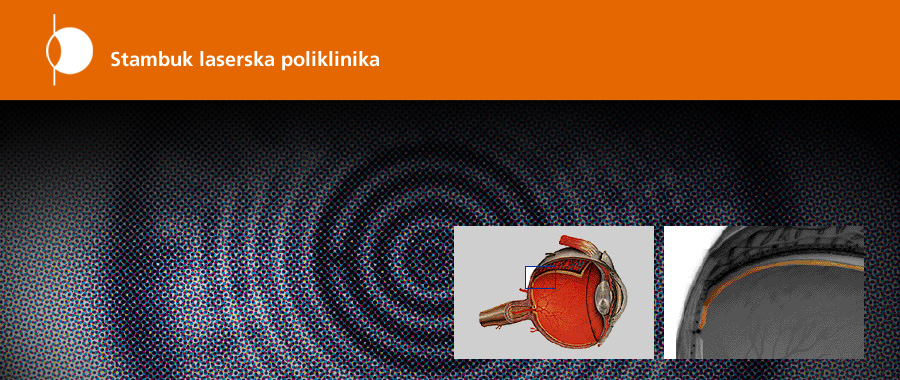


oftalmologija
grada oka
conjunctiva
cornea
choroid
iris
lens
anterior ocular chamber
posterior ocular chamber
optic nerve
retina
grada oka
conjunctiva
cornea
choroid
iris
lens
anterior ocular chamber
posterior ocular chamber
optic nerve
retina
Retina
The retina is a thin, transparent membrane. It is on the light sensitive retina that images are formed. The retina is the innermost of the three concentric layers of the eyeball. The retina is enclosed in a dark-brown pigmented capsule. Light is not transmitted through this capsule. The retina is an extension of the brain and contains the cells for vision; the rods and cones. It is here that light stimulus is changed into neuronal stimulation through photochemical processes. The center of the retina has a small groove. This is the macula which contains only cones and where vision is sharpest. This rod-free visual groove lies along the visual axis which is optically the midpoint of the retina. The cones here are clustered closely together over an area of 5 gmm and enable visual acuity as well as colour vision. Rods cover the majority of the periphery and serve for vision in poor light and spacial awareness. The light sensitive rods and cones are found deep within the retina and not on the surface.
The retina is a thin, transparent membrane. It is on the light sensitive retina that images are formed. The retina is the innermost of the three concentric layers of the eyeball. The retina is enclosed in a dark-brown pigmented capsule. Light is not transmitted through this capsule. The retina is an extension of the brain and contains the cells for vision; the rods and cones. It is here that light stimulus is changed into neuronal stimulation through photochemical processes. The center of the retina has a small groove. This is the macula which contains only cones and where vision is sharpest. This rod-free visual groove lies along the visual axis which is optically the midpoint of the retina. The cones here are clustered closely together over an area of 5 gmm and enable visual acuity as well as colour vision. Rods cover the majority of the periphery and serve for vision in poor light and spacial awareness. The light sensitive rods and cones are found deep within the retina and not on the surface.